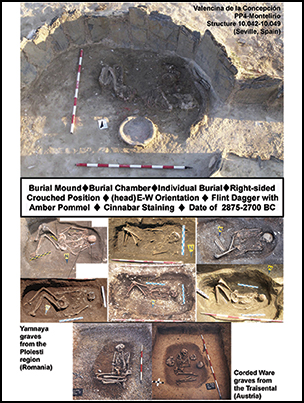Crossref Citations
This article has been cited by the following publications. This list is generated based on data provided by
Crossref.
Hofmann, Daniela
2015.
Theorie muss sein.
EAZ – Ethnographisch-Archaeologische Zeitschrift,
Vol. 56,
Issue. 1/2,
p.
31.
Marila, Marko
2017.
Vagueness and Archaeological Interpretation: A Sensuous Approach to Archaeological Knowledge Formation through Finds Analysis.
Norwegian Archaeological Review,
Vol. 50,
Issue. 1,
p.
66.
Kristiansen, Kristian
Allentoft, Morten E.
Frei, Karin M.
Iversen, Rune
Johannsen, Niels N.
Kroonen, Guus
Pospieszny, Łukasz
Price, T. Douglas
Rasmussen, Simon
Sjögren, Karl-Göran
Sikora, Martin
and
Willerslev, Eske
2017.
Re-theorising mobility and the formation of culture and language among the Corded Ware Culture in Europe.
Antiquity,
Vol. 91,
Issue. 356,
p.
334.
Bourgeois, Quentin
Kroon, Erik
and
Biehl, Peter F.
2017.
The impact of male burials on the construction of Corded Ware identity: Reconstructing networks of information in the 3rd millennium BC.
PLOS ONE,
Vol. 12,
Issue. 10,
p.
e0185971.
Gerasimov, Dmitriy Vladimirovitch
and
Kholkina, Margarita Alekseevna
2017.
Formation of social-cultural units in the Gulf of Finland region in changing Early and Middle Holocene environment.
Samara Journal of Science,
Vol. 6,
Issue. 3,
p.
177.
Scarre, Chris
2017.
EDITORIAL.
Antiquity,
Vol. 91,
Issue. 360,
p.
1413.
Furholt, Martin
2018.
Massive Migrations? The Impact of Recent aDNA Studies on our View of Third Millennium Europe.
European Journal of Archaeology,
Vol. 21,
Issue. 2,
p.
159.
Veeramah, Krishna R
2018.
The importance of fine-scale studies for integrating paleogenomics and archaeology.
Current Opinion in Genetics & Development,
Vol. 53,
Issue. ,
p.
83.
Guilaine, Jean
2018.
Siret’s smile.
Antiquity,
Vol. 92,
Issue. 365,
p.
1247.
Callaway, Ewen
2018.
Divided by DNA: The uneasy relationship between archaeology and ancient genomics.
Nature,
Vol. 555,
Issue. 7698,
p.
573.
Eisenmann, Stefanie
Bánffy, Eszter
van Dommelen, Peter
Hofmann, Kerstin P.
Maran, Joseph
Lazaridis, Iosif
Mittnik, Alissa
McCormick, Michael
Krause, Johannes
Reich, David
and
Stockhammer, Philipp W.
2018.
Reconciling material cultures in archaeology with genetic data: The nomenclature of clusters emerging from archaeogenomic analysis.
Scientific Reports,
Vol. 8,
Issue. 1,
Furholt, Martin
2019.
Re-integrating Archaeology: A Contribution to aDNA Studies and the Migration Discourse on the 3rd Millennium BC in Europe.
Proceedings of the Prehistoric Society,
Vol. 85,
Issue. ,
p.
115.
Barrett, John
2019.
The Archaeology of Population Dynamics.
Current Swedish Archaeology,
Vol. 27,
Issue. 27,
p.
37.
Knitter, Daniel
Brozio, Jan Piet
Dörfler, Walter
Duttmann, Rainer
Feeser, Ingo
Hamer, Wolfgang
Kirleis, Wiebke
Müller, Johannes
and
Nakoinz, Oliver
2019.
Transforming landscapes: Modeling land-use patterns of environmental borderlands.
The Holocene,
Vol. 29,
Issue. 10,
p.
1572.
Rosenstock, Eva
Ebert, Julia
Martin, Robert
Hicketier, Andreas
Walter, Paul
and
Groß, Marcus
2019.
Human stature in the Near East and Europe ca. 10,000–1000 BC: its spatiotemporal development in a Bayesian errors-in-variables model.
Archaeological and Anthropological Sciences,
Vol. 11,
Issue. 10,
p.
5657.
Mallory, J.
Dybo, A.
and
Balanovsky, O.
2019.
The Impact of Genetics Research on Archaeology and Linguistics in Eurasia.
Russian Journal of Genetics,
Vol. 55,
Issue. 12,
p.
1472.
Marila, Marko
2019.
Slow science for fast archaeology.
Current Swedish Archaeology,
Vol. 27,
Issue. 27,
p.
93.
Kyselý, René
Dobeš, Miroslav
and
Svoboda, Karel
2019.
Drilled teeth and shell artefacts from a graveat Prague-Březiněves and a review of decorative artefacts made from animal material from Corded Ware culture in the Czech Republic.
Archaeological and Anthropological Sciences,
Vol. 11,
Issue. 1,
p.
87.
Hanscam, Emily
2019.
Postnationalism and the Past: The Politics of Theory in Roman Archaeology.
Theoretical Roman Archaeology Journal,
Vol. 2,
Issue. 1,
McHugo, Gillian P.
Dover, Michael J.
and
MacHugh, David E.
2019.
Unlocking the origins and biology of domestic animals using ancient DNA and paleogenomics.
BMC Biology,
Vol. 17,
Issue. 1,



